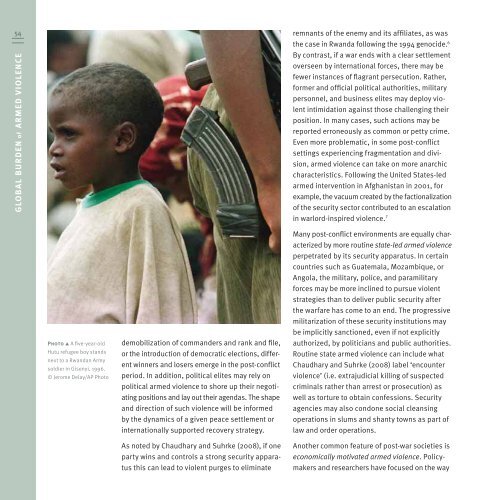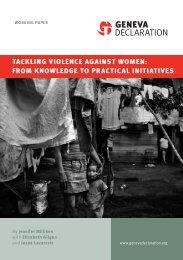Global Burden of Armed Violence - The Geneva Declaration on ...
Global Burden of Armed Violence - The Geneva Declaration on ...
Global Burden of Armed Violence - The Geneva Declaration on ...
Create successful ePaper yourself
Turn your PDF publications into a flip-book with our unique Google optimized e-Paper software.
54<br />
GLOBAL BURDEN <str<strong>on</strong>g>of</str<strong>on</strong>g> ARMED VIOLENCE<br />
Photo ! A five-year-old<br />
Hutu refugee boy stands<br />
next to a Rwandan Army<br />
soldier in Gisenyi, 1996.<br />
© Jerome Delay/AP Photo<br />
demobilizati<strong>on</strong> <str<strong>on</strong>g>of</str<strong>on</strong>g> commanders and rank and file,<br />
or the introducti<strong>on</strong> <str<strong>on</strong>g>of</str<strong>on</strong>g> democratic electi<strong>on</strong>s, different<br />
winners and losers emerge in the post-c<strong>on</strong>flict<br />
period. In additi<strong>on</strong>, political elites may rely <strong>on</strong><br />
political armed violence to shore up their negotiating<br />
positi<strong>on</strong>s and lay out their agendas. <str<strong>on</strong>g>The</str<strong>on</strong>g> shape<br />
and directi<strong>on</strong> <str<strong>on</strong>g>of</str<strong>on</strong>g> such violence will be informed<br />
by the dynamics <str<strong>on</strong>g>of</str<strong>on</strong>g> a given peace settlement or<br />
internati<strong>on</strong>ally supported recovery strategy.<br />
As noted by Chaudhary and Suhrke (2008), if <strong>on</strong>e<br />
party wins and c<strong>on</strong>trols a str<strong>on</strong>g security apparatus<br />
this can lead to violent purges to eliminate<br />
remnants <str<strong>on</strong>g>of</str<strong>on</strong>g> the enemy and its affiliates, as was<br />
the case in Rwanda following the 1994 genocide. 6<br />
By c<strong>on</strong>trast, if a war ends with a clear settlement<br />
overseen by internati<strong>on</strong>al forces, there may be<br />
fewer instances <str<strong>on</strong>g>of</str<strong>on</strong>g> flagrant persecuti<strong>on</strong>. Rather,<br />
former and <str<strong>on</strong>g>of</str<strong>on</strong>g>ficial political authorities, military<br />
pers<strong>on</strong>nel, and business elites may deploy violent<br />
intimidati<strong>on</strong> against those challenging their<br />
positi<strong>on</strong>. In many cases, such acti<strong>on</strong>s may be<br />
reported err<strong>on</strong>eously as comm<strong>on</strong> or petty crime.<br />
Even more problematic, in some post-c<strong>on</strong>flict<br />
settings experiencing fragmentati<strong>on</strong> and divisi<strong>on</strong>,<br />
armed violence can take <strong>on</strong> more anarchic<br />
characteristics. Following the United States-led<br />
armed interventi<strong>on</strong> in Afghanistan in 2001, for<br />
example, the vacuum created by the facti<strong>on</strong>alizati<strong>on</strong><br />
<str<strong>on</strong>g>of</str<strong>on</strong>g> the security sector c<strong>on</strong>tributed to an escalati<strong>on</strong><br />
in warlord-inspired violence. 7<br />
Many post-c<strong>on</strong>flict envir<strong>on</strong>ments are equally characterized<br />
by more routine state-led armed violence<br />
perpetrated by its security apparatus. In certain<br />
countries such as Guatemala, Mozambique, or<br />
Angola, the military, police, and paramilitary<br />
forces may be more inclined to pursue violent<br />
strategies than to deliver public security after<br />
the warfare has come to an end. <str<strong>on</strong>g>The</str<strong>on</strong>g> progressive<br />
militarizati<strong>on</strong> <str<strong>on</strong>g>of</str<strong>on</strong>g> these security instituti<strong>on</strong>s may<br />
be implicitly sancti<strong>on</strong>ed, even if not explicitly<br />
authorized, by politicians and public authorities.<br />
Routine state armed violence can include what<br />
Chaudhary and Suhrke (2008) label ‘encounter<br />
violence’ (i.e. extrajudicial killing <str<strong>on</strong>g>of</str<strong>on</strong>g> suspected<br />
criminals rather than arrest or prosecuti<strong>on</strong>) as<br />
well as torture to obtain c<strong>on</strong>fessi<strong>on</strong>s. Security<br />
agencies may also c<strong>on</strong>d<strong>on</strong>e social cleansing<br />
operati<strong>on</strong>s in slums and shanty towns as part <str<strong>on</strong>g>of</str<strong>on</strong>g><br />
law and order operati<strong>on</strong>s.<br />
Another comm<strong>on</strong> feature <str<strong>on</strong>g>of</str<strong>on</strong>g> post-war societies is<br />
ec<strong>on</strong>omically motivated armed violence. Policymakers<br />
and researchers have focused <strong>on</strong> the way









